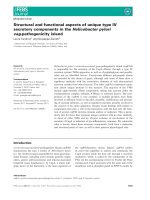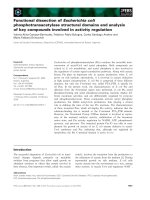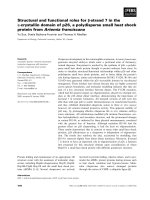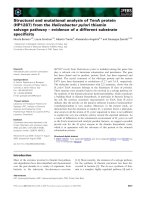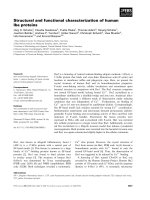Structural and functional analysis of critical proteins involved in mRNA decay
Bạn đang xem bản rút gọn của tài liệu. Xem và tải ngay bản đầy đủ của tài liệu tại đây (6.63 MB, 191 trang )
STRUCTURAL AND FUNCTIONAL
ANALYSIS OF CRITICAL PROTEINS
INVOLVED IN mRNA DECAY
CHENG ZHIHONG
NATIONAL UNIVERSITY OF SINGAPORE
2006
STRUCTURAL AND FUNCTIONAL
ANALYSIS OF CRITICAL PROTEINS
INVOLVED IN mRNA DECAY
CHENG ZHIHONG
(B.Sc)
Ease China University of Science and Technology
A THESIS SUBMITTED
FOR THE DEGREE OF DOCTOR OF PHILOSOPHY
DEPARTMENT OF BIOLOGICAL SCIENCES
NATIONAL UNIVERSITY OF SINGAPORE
2006
To My Wife
i
Index
Index………………………………………………………………………………………i
Acknowledgements …………………………………………………………….……… ii
Table of Contents……………………………………………………………………… iii
Abstract …………………………………………………………………………… viii
Lists of Figures…………………………………………………………………… … x
Lists of Tables ……………………………………………………………………….…xii
Lists of Abbreviations ……………………………………………………………… xiii
References………………………………………………………………………… …147
Appendix I MOPS Minimal Medium …………………………………………… 168
Appendix II Publication list…………………………………………………………170
ii
Acknowledgements
I would like to thank sincerely my supervisor, Dr Song Haiwei, for offering me an
opportunity being a postgraduate. Without his great guidance, patience and advice, I
could not finish my Ph.D program successfully.
Many thanks also go to our collaborator from Howard Hughes Medical Institute,
The University of Arizona, Professor Roy Parker, Drs. Jeff Coller and Denise Muhlrad,
for their great experiment data and precious discussions.
I would like to give my appreciation to the members of my thesis committee:
Associate Professor Kunchithapadam Swaminathan, Associate Professor Wang Yue from
Institute of Molecular and Cell (IMCB) and Assistant Professor J Sivaraman from
Department of Biological Sciences (NUS), for guidance and discussions throughout my
studies.
I also thank all my colleagues in my laboratory for their kind help. Thanks
especially go to Dr. Kong Chunguang, Dr. Wu Mousheng, Miss She Meipei, Miss Chen
Nan and Dr Zhou Zhihong for all the valuable discussions in all the experiments. I want
to thank Dr. Christian, Dr. Rohini, Miss Portia and Sharon, for their critical reading of the
manuscript of this thesis, and Lim Mengkiat for his great help in the experiment.
I also thank all administrative staffs in Department of Biological Sciences (NUS)
and IMCB for their supports. Thanks also go to the shared facilities in IMCB including
DNA sequencing facility and Mass Spectrometry facility for experimental supports.
Finally, I would like to thank my family, especially my wife for her full support,
patience, encouragement and inspiration all the time. I could not image the situation
without her precious support.
iii
Table of contents
Chapter 1 Introduction
1.1. Biological significance of mRNA decay……………………………………… 1
1.2. General mRNA decay pathway…………………………………………………1
1.2.1. Deadenylation…………………………………………………………… 4
1.2.2. Decapping……………………………………………………………… 6
1.2.2.1. The Dcp1-Dcp2 Decapping enzyme complex………………………6
1.2.2.2. Regulation of the decapping activity…………………………… 7
1.2.2.3. Scavenger decapping enzyme DcpS……………………………… 9
1.2.3. Enzymes involved in mRNA body degradation…………………………10
1.2.3.1. 5’ to 3’ degradation by Xrn1……………………………………….10
1.2.3.2. 3’ to 5’ degradation by the exosome complex………………… 11
1.3. mRNA quality control mechanisms targeting aberrant mRNAs………………13
1.3.1. Nonsense-mediated mRNA decay…………………………………… 13
1.3.1.1. NMD factors……………………………………………………….15
1.3.1.2. Translation and NMD…………………………………………… 16
1.3.1.3. Definition of premature termination codons……………………….18
1.3.1.4. Recognition of PTC in mammals……………………………… 20
1.3.2. Nonstop mRNA decay ………………………………………………… 22
1.4. Specialized mRNA decay pathways………………………………………… 23
1.5. Project I: Structural and functional studies of Ski8………………………… 27
1.5.1. Brief introduction of Ski8……………………………………………… 27
iv
1.5.2. Structural characteristics of WD-repeat proteins……………………… 29
1.5.3. Aims of this project………………………………………………………33
1.6. Project II: Structural and functional studies of Dhh1…………………………34
1.6.1. Brief review of Dhh1…………………………………………………….34
1.6.2. Structural characterization of Superfamily 2 helicases…………… 35
1.6.3. Aims of this project………………………………………………………40
1.7. Project III: Structural and functional analysis of hUpf1……………………….41
1.7.1. Previous functional and biochemical studies of Upf1……………… 41
1.7.2. Structural studies of Superfamily 1 helicases……………………………43
1.7.3. Aims of this project………………………………………………………44
Chapter 2 Cloning, Protein Purification, Crystallization and Structure
Determination
2.1. Gene cloning and protein expression strain construction…………………… 45
2.1.1. Yeast genomic DNA isolation………………………………………… 45
2.1.2. Polymerase chain reaction (PCR) ……………………………………….45
2.1.3. Agarose gel electrophoresis…………………………………………… 46
2.1.4. Purification of PCR products…………………………………………….46
2.1.5. Enzyme digestion, dephosphorylation and purification…………… 46
2.1.6. Ligation and transformation………………………………………… 47
2.1.7. Plasmid preparation and positive clone screening……………………….47
2.1.8. DNA sequencing……………………………………………………… 47
2.1.9. E. coli expression strain transfomation ………………………………….48
2.1.10. Protein expression test and expression strain storage……………………48
2.1.11. SDS-PAGE………………………………………………………………48
v
2.2. Protein purification………………………………………………………… 49
2.2.1. Large-scale cell culture for protein expression………………………… 49
2.2.2. Purification procedures……………………………………………… 49
2.2.2.1. Cell lysis………………………………………………………… 51
2.2.2.2. First GST affinity column chromatography……………………….51
2.2.2.3. Second GST affinity column chromatography…………………….51
2.2.2.4. Ion exchange chromatography………………………………… 51
2.2.2.5. Gel filtration chromatography………………………………… 52
2.3. Crystallization……………………………………………………………… 53
2.4. Structure determination…………………………………………………… 55
2.4.1. Heavy atom derivative preparation………………………………… 55
2.4.2. Data collection and processing………………………………………… 56
2.4.2.1. Data collection and processing of SeMet Ski8…………………….56
2.4.2.2. Data collection and processing of the Br derivative of Dhh1…… 57
2.4.2.3. Data collection and processing of SeMet hUpf1……………… 58
2.4.3. Structure determination………………………………………………… 59
2.4.3.1. Phasing, modeling and refinement of Ski8…………………… 59
2.4.3.2. Phasing, modeling and refinement of Dhh1……………………….62
2.4.3.3. Structure determination of hUpf1………………………………….65
2.5. Biochemical and molecular biological experiments……………………… 72
2.5.1. Experiments for Ski8………………………………………………… 72
2.5.1.1. Site-directed mutagenesis and yeast two-hybrid assay……………72
2.5.1.2. GST pull-down assay…………………………………………… 72
vi
2.5.2. Experiments for Dhh1……………………………………………………73
2.5.2.1. CD-spectroscopy………………………………………………… 73
2.5.2.2. Mutagenesis and in vivo mRNA turnover assays………………….73
2.5.2.3. Limited Proteolysis……………………………………………… 74
2.5.2.4. In vitro RNA binding assay……………………………………… 74
2.5.3. Experiments for hUpf1………………………………………………… 75
2.5.3.1. Mutagenesis and In vitro ATPase activity…………………………75
2.5.3.2 In vitro ATP binding assay……………………………………… 75
2.5.3.3. In vitro RNA binding assay……………………………………… 76
2.5.3.4. In vivo NMD analysis and P-body formation………………… 76
2.5.3.5. Surface plasmon resonance (SPR) ……………………………… 77
Chapter 3 Crystal Structure and Mutagenesis Studies of Ski8
3.1. Results…………………………………………………………………………78
3.1.1. Overall structure determination………………………………………….78
3.1.2. Comparison with other WD repeat proteins…………………………… 80
3.1.3. Location of protein-protein interaction sites on the β propeller…………83
3.1.4. Mutational Analysis of Ski8…………………………………………… 87
3.2. Discussion………………………………………………………………… ….90
Chapter 4 Structural and Functional Analysis of Dhh1
4.1. Results ……………………………………………………………………… 94
4.1.1. Structural overview of the Dhh1…………………………………………94
4.1.2. Structural Comparison ……………………………………………… 96
4.1.3. Location of the conserved sequence motifs…………………………… 98
vii
4.1.4. Interactions of the conserved Motifs……………………………………103
4.1.5. Identification of residues required for RNA binding ………………… 107
4.1.6. Conformational changes in Dhh1………………………………………114
4.2. Discussion………… ……………………………………………………… 116
Chapter 5 Structural and Functional Insights into hUpf1
5.1. Results……………………………………………………………………… 120
5.1.1. Overall structure ……… ………………………………………………120
5.1.2. Nucleotide Binding site and ATP hydrolysis………………………… 124
5.1.3. Conformational change during the Upf1 ATPase cycle……………… 128
5.1.4. Allosteric effect of ATP binding coupled with RNA binding .……… 133
5.1.5. Differential effects of Upf1 mutants on P-body formation…………… 141
5.2. Discussion………………………………………………………………… 143
viii
Abstract
The control of mRNA translation and degradation is important for gene
expression in eukaryotic cells. mRNA decay, including mRNA quality control, is a multi-
step processing event composed of deadenylation, decapping and degradation of the
mRNA body. Three proteins, hUpf1, Dhh1 and Ski8 involved in eukaryotic mRNA decay
were structurally and functionally studied in this thesis.
Ski8 is a WD-repeat protein with an essential role for the Ski complex assembly
in an exosome-dependent 3'-to-5' mRNA decay. Additionally, Ski8 is involved in meiotic
recombination by interacting with Spo11. Crystal structure of Ski8 from Saccharomyces
cerevisiae was determined at 2.2Å resolution. It reveals that Ski8 folds into a seven-
bladed beta propeller. Mapping sequence conservation and hydrophobicities of amino
acids on the molecular surface of Ski8 reveals a prominent site on the top surface of the
beta propeller. It was proposed that this top surface mediates interactions of Ski8 with
Ski3 and Spo11, which was confirmed by mutagenesis combined with yeast two-hybrid
and GST pull-down assays. The functional implications for Ski8 function in both mRNA
decay and meiotic recombination was also discussed.
Dhh1, a DEAD-box protein, functions both to repress translation and enhance
decapping. The crystal structure of the N- and C-terminal truncated Dhh1 from budding
yeast was determined at 2.1Å resolution. The structure reveals that truncated Dhh1 is
composed of two RecA-like domains with a unique arrangement. In contrast to the
structures of eIF4A and mjDEAD, in which no motif interactions exist, motif V in Dhh1
interacts with motif I and the Q-motif, thereby linking the two domains together.
ix
Electrostatic potential mapping combined with mutagenesis reveals that motifs I, V, and
VI are involved in RNA binding. In addition, trypsin digestion of the truncated Dhh1 in
the absence or presence of RNA or ligand suggests that ATP binding enhances an RNA-
induced conformational change. Interestingly, some mutations located in the conserved
motifs and at the interface between the two RecA-like domains confer dominant negative
phenotypes in vivo and disrupt the conformational switch in vitro, suggesting that this
conformational change is required for Dhh1 function.
Upf1 is a critical protein involved in triggering nonsense-mediated mRNA decay,
an mRNA surveillance pathway that recognizes and degrades aberrant mRNAs
containing premature stop codons. Upf1 belongs to the helicase Superfamily 1 (SF1), and
is thought to utilize the energy of ATP hydrolysis to promote transitions in the structure
of RNA or RNA-protein complexes. The crystal structure of the catalytic core of human
Upf1 determined in three states (phosphate-, AMPPNP- and ADP-bound forms) reveals
an overall structure composed of two RecA-like domains with two additional domains
protruding from the N-terminal RecA-like domain. Structural comparison combined with
mutagenesis studies identified a likely ssRNA binding channel, and a cycle of
conformational change coupled to ATP binding and hydrolysis. These conformational
changes alter the likely ssRNA-binding channel in a manner that can explain how ATP
binding destabilizes ssRNA binding to Upf1.
Keywords: mRNA decay, nonsense-mediated mRNA decay, WD-repeat protein, Ski8,
DEAD-box protein, Dhh1, RNA helicase, Upf1, X-ray crystallography
x
Lists of Figures
Figure 1-1 General mRNA decay pathway………………………………………… 3
Figure 1-2 General models for nonsense-mediated mRNA decay (NMD)
in S. cerevisiae and mammalian cells……………………………………14
Figure 1-3 A proposed model for mammalian NMD ……………………………….21
Figure 1-4 The general model for nonstop-mediated mRNA decay (NSD)
in S. cerevisiae………………………………………………………… 23
Figure 1-5 Architecture of the β-propeller fold………………………………… 30
Figure 1-6 A diagrammatic representation of one blade of the WD-repeat
protein………………………………………………………………… 31
Figure 1-7 Architecture of WD-repeat protein in protein complex…………… 33
Figure 1-8 Crystal structures of Superfamily 2 helicases……………………… 40
Figure 1-9 Crystal structures of Superfamily 1 helicases……………………… 44
Figure 2-1 Purification of Ski8…………………………………………………… 52
Figure 2-2 Purification of Dhh1…………………………………………………… 53
Figure 2-3 Purification of hUpf1………………………………………………… 53
Figure 2-4 Crystals of Ski8, Dhh1 and hUpf1, as well as hUpf1 in complex
with AMPPNP, ATPγS and ADP……………………………………… 55
Figure 2-5 A partial electron density map of Ski8 shown in the program O……… 60
Figure 2-6 Flow chart of structure determination of Ski8………………………… 61
Figure 2-7 A partial electron density map of Dhh1 shown in the program O……….63
Figure 2-8 Flow chart of structure determination of Dhh1………………………… 64
Figure 2-9 Flow chart of structure determination of hUpf1…………………… 67
Figure 2-10 Evaluation of 1000 trials by SnB program………………………………68
Figure 2-11 A partial electron density map of hUpf1-AMPPNP shown in the
program ………………………………………………………………….69
Figure 3-1 Overall structure of Ski8…………………………………………………79
Figure 3-2 Sequence alignment of Ski8 homologs……………………………… 82
Figure 3-3 Comparison of Ski8p with Gβ and Tup1c……………………………….83
Figure 3-4 Molecular surface views of Ski8…………………………………………85
xi
Figure 3-5 Location of the protein-protein interactions site on the top face
of the β propeller…………………………………………………………86
Figure 3-6 Mutational analysis of Ski8 mutants…………………………………… 89
Figure 4-1 Orthogonal view of tDhh1…………………………………………… 96
Figure 4-2 Sequence alignment of S. cerevisiae Dhh1, H. sapiens Rck/p54,
S. cerevisiae eIF4A and M. janaschii mjDEAD…………………………99
Figure 4-3 Comparison of tDhh1 with eIF4A and mjDEAD………………………102
Figure 4-4 Stereo view of interactions of the conserved motifs……………………106
Figure 4-5 CD spectroscopy of various single mutants, double mutants and
wild-type Dhh1…………………………………………………………108
Figure 4-6 In vitro RNA binding assay of Dhh1………………………………… 109
Figure 4-7 In vivo mutagenesis analysis of Dhh1……………………………… 113
Figure 4-8 Analysis of limited trypsin digestion of Dhh1………………………….115
Figure 4-9 Comparison of Dhh1 to eIF-4A……………………………………… 119
Figure 5-1 Domain structure of hUpf1 and sequence alignment of the
helicase core domain……………………………………………………122
Figure 5-2 Structure of hUpf1hd and its comparison with PcrA and Vasa
helicases……………………………………………………………… 123
Figure 5-3 Nucleotide binding and hydrolysis of hUpf1hd…………………… 127
Figure 5-4 Conformational changes of hUpf1hd upon nucleotide binding
and hydrolysis………………………………………………………… 132
Figure 5-5 Protein gel filtration profile of hUpf1 WT and mutants 1B∆
and 1C∆……………………………………………………………… 133
Figure 5-6 The channel between domains 1B and 1C involved in ssRNA
binding………………………………………………………………….135
Figure 5-7 Allosteric effects of ATP binding/hydrolysis on RNA binding……… 137
Figure 5-8 Surface plasma resonance analysis of RNA binding to hUpf1…………139
Figure 5-9 Structure comparison of hUpf1hd-AMPPNP with
hUpf1hd-ATPγS……………………………………………………… 141
Figure 5-10 Visualization of Dcp2-GFP in live yeast strains expressing
Upf1 mutants………………………………………………………… 143
xii
Lists of Tables
Table 1-1 Critical proteins involved in general mRNA decay pathway…………… 3
Table 1-2 Regulators of mRNA decapping……………………………………… 9
Table 1-3 Components of the exosome…………………………………………… 12
Table 1-4 NMD factors in eukaryotic cells…………………………………………16
Table 1-5 Biochemical properties of the conserved motifs of RNA helicases…… 36
Table 1-6 Crystal structures of helicases in the Protein Data Bank……………… 37
Table 1-7 Summaries of biochemical properties of Upf1 mutants…………… 43
Table 2-1 Purification procedures of Ski8, Dhh1 and hUpf1……………………….50
Table 2-2 Recipes of buffers used for purification………………………………….50
Table 2-3 Crystallization conditions and cryo-protectants used for
Ski8 and Dhh1……………………………………………………… ….54
Table 2-4 Crystallization conditions and cryo-protectants used for hUpf1……… 54
Table 2-5 Statistics of the data collection and processing of Ski8………………….57
Table 2-6 Statistics of the data collection and processing of Dhh1……………… 58
Table 2-7 Statistics of the data collection and processing of hUpf1……………… 59
Table 2-8 Se atom sites of Ski8 found by the program SOLVE……………… 60
Table 2-9 Phase determination and refinement statistics of Ski8 structure……… 62
Table 2-10 Br
atom sites found by the program SOLVE…………………………….63
Table 2-11 Phase determination and refinement statistics of Dhh1 structure……… 65
Table 2-12 Se atom sites found by the program SnB…………………………… 66
Table 2-13 Result of rotation function by Molrep using domain 1A as
a searching model……………………………………………………… 70
Table 2-14 Result of rotation function by Molrep using domain 2A as
a searching model and fixing two copies of domain 1A…………………70
Table 2-15 Phase determination and refinement statistics of hUpf1…………………71
xiii
Lists of Abbreviations
AMPPNP Adenosine 5′-(β,γ-imido)triphosphate tetralithium salt hydrate
ADP adenosine diphosphate
AMD ARE-mediated mRNA decay
ARE AU-rich element
ATP adenosine triphosphate
ATPγS adenosine 5 -[γ-thio]triphosphate
ATR ATM and Rad3-related
Arf ADP-ribosylation factor
CCP4 collaborative computational project No.4
CNS crystallography and NMR system
DSE Downstream sequence elements
DTT dithiothreitol
EDTA ethylenediaminetetraacetic acid
EJC Exon-junction complex
Gal4-BD Gal4 DNA binding domain
Gal4-AD Gal4 DNA activating domain
GST Glutathione-S-transferase
GTPase GTP hydrolase
IPTG isopropyl β-D-thiogalactopyranoside
kD kilo Dalton
M molar
xiv
MAD Multiple-wavelength anomalous dispersion
ml milliliter
mM millimolar
mg milligram
NCS non-crystallographic symmetry
NGD No-go mRNA decay
NSD Non-stop mRNA decay
nm nanometer
NMD Nonsense-mediated decay
OD optical density
PAGE poly-acrylamide gel electrophoresis
PCR polymerase chain reaction
PEG polyethylene glycol
PI3K phosphoinositide 3-kinase
PMSF phenyl-methyl-sulfonyl fluoride
PTC Premature termination codon
RCC1 regulator of chromosome condensation 1
RISC RNA-induced silencing complex
SAD Single-wavelength anomalous dispersion
SDS sodium dodecyl sulfate
siRNA Small interference RNAs
SLBP Stem-loop binding protein
SMD Staufen1-mediated decay
xv
SURF SMG1, Upf1, release factors eRF1 and eRF3
Tris Tris(hydroxymethyl)aminomethane
WT wide type
µl microliter
µM micromolar
UV ultraviolet
1
Chapter 1
Introduction
1.1 Biological significance of mRNA decay
During the lifetime of a cell, eukaryotic mRNAs are bound by a large number of
proteins, which change in coordination with various processing events. This requires
gene expression to be tightly regulated and permits a cell to alter its pattern of protein
synthesis in response to changing physiological conditions. Eukaryotic gene expression
can be controlled at several different levels including transcription, splicing and export,
translation, post-translational modification and protein localization and degradation. In
addition to these processing events, mRNA turnover becomes a critical control point for
regulating gene expression. mRNA decay targets not only endogenous mRNA molecules,
but also viral double-stranded RNAs (dsRNAs) for antiviral defense in a specialized
pathway termed RNA interference (RNAi) (van Hoof et al., 2002; Waterhouse et al.,
2001). Moreover, eukaryotic cells have evolved specialized mRNA decay mechanisms to
recognize and degrade the aberrant mRNAs generated during transcription due to
frequent mutations or faulty splicing, thereby increasing the quality control of mRNA
biogenesis and protein synthesis (Maquat et al., 2001).
1.2 General mRNA decay pathway
Various mRNAs in eukaryotes have different half-lives. For instance, in yeast the
most unstable RNAs have a half-life of about 2-3 minutes while stable RNAs can survive
2
more than 90 minutes. In higher eukaryotes unstable mRNAs have a half-life of 15
minutes while stable mRNAs may exist for more than 24 hours (Herrick et al., 1990;
Wang et al., 2002; Shyu et al., 1989). Two general mRNA decay pathways exist in
eukaryotes and both are deadenylation-dependent and initiated by the removal of the
poly(A) tail at the 3’ end (Figure 1-1; Meyer et al., 2004; Coller et al., 2004; Parker et
al., 2004). Subsequently, deadenylated mRNAs are degraded by cleavage of the 5’-cap
structure by the Dcp1-Dcp2 decapping complex (Decapping proteins) , followed by 5’ to
3’ degradation by the Xrn1 exonuclease (Exoribonuclease 1; Decker et al., 1993; Steiger
et al., 2003; Larimer et al., 1992). Alternatively, poly(A)-shortened mRNAs can be
degraded in a 3’ to 5’ direction by the exosome, a large protein complex consisting of 10
exonucleases with the aid of Ski7 and the Ski2/3/8 complex (Jacobs et al., 1998;
Mukherjee et al., 2002). The residue 5’-cap structure is then cleaved by a scavenger
enzyme DcpS (van Dijk et al., 2003).
In addition to deadenylation-dependent 5’ to 3’ and 3’ to 5’ degradation, some
eukaryotic mRNAs are degraded by endonucleolytic cleavage without deadenylation
(Figure 1-1). Examples include Transferrin receptor, Vitellogenin and Xenopus β-globin
mRNAs (Bremer et al., 2003; Binder et al., 1994; Cunningham et al., 2000), which have a
wide variety of endonucleolytic cleavage sites. The general pathways of eukaryotic
mRNA decay are illustrated in Figure 1-1 and critical enzymes and regulators are
summarized in Table 1-1.
3
Enzymes Processing step
Yeast Mammals
Regulators
Deadenylation Pan2-Pan3
CCR4-NOT
complex
Pan2-Pan3
CCR4-NOT
complex
PARN
PABPC
Cap
Decapping Dcp1-Dcp2 Dcp1-Dcp2 Edc1, Edc2,Edc3
Pat1,Lsm1-7,
Dhh1, PABPC
Cap hydrolysis Dcs1 DcpS
5’-3’ degradation Xrn1 Xrn1
3’-5’ degradation Exosome Exosome Ski2/3/8 complex,
Ski7
Table 1-1 Critical proteins involved in general mRNA decay pathway
Figure 1-1 General mRNA decay pathway. The first step in decay is shortening of the poly(A) tail,
which can be catalyzed by several different enzymes. Following deadenylation, the body of the
mRNA is attacked from either the 5’ or 3’ ends. The 5’ to 3’ decay pathway is initiated by
cleavage of the cap structure by the decapping complex Dcp1-Dcp2, followed by 5’→3’
exonucleolytic degradation by Xrn1. 3’ to 5’ decay is catalyzed by a large complex of
exonucleases termed the exosome, leading to production of 5’ cap structure, which can be broken
down by the scavenger decapping protein DcpS. Decay of some mRNAs are initiated by
endonucleolytic digestion.
4
1.2.1 Deadenylation
Deadenylation is the first and rate-limiting step in the degradation of regular
mRNA from yeast to higher eukaryotes. To date, three different proteins or protein
complexes have been identified as mRNA deadenylases involved in mRNA degradation
(Parker et al., 2004).
The Ccr4-Not complex is the predominant enzyme controlling the mRNA poly(A)
tail length in Saccharomyces cerevisiae. In addition to the two nucleases, Ccr4 and Pop2,
this complex also contains several accessory proteins, Not1 to Not5, Caf4, Caf16, Caf40
and Caf130 (Tucker et al., 2001; Denis et al, 2003; Martine A. Collart 2003). The most
important nuclease in the Ccr4-Not complex is Ccr4 (carbon catabolite repressor 4
factor), which was first identified as a gene expression regulator (Denis et al., 1984), then
later found to be involved in mRNA deadenylation (Tucker et al., 2001). Sequence
analysis shows that Ccr4 belongs to the ExoIII family of nucleases (Dlakic M. 2000). It
has been shown that the activity of Ccr4 is inhibited by the poly(A)-binding protein
(Pab1), but not affected by the cap structure of the mRNA, suggesting its preference for
mRNA substrates with a shorter poly(A) tail (Tucker et al., 2001; Viswanathan et al.,
2003). The second protein in the Ccr4-Not complex with deadenylase activity is
Pop2/Caf1 (PGK-promoter directed overproduction/Ccr4-associated factor 1; Daugeron
et al., 2001). Pop2 belongs to the DEDD nuclease superfamily composed of RNases and
DNases (Daugeron et al., 2001; Zuo et al., 2001). A recently reported crystal structure of
the RNase D domain from yeast Pop2 shows that the nuclease domain adopts a similar
fold to DNA exonucleases. These enzymes are proposed to coordinate two divalent metal
ions in the active site to catalyze hydrolysis of the phosphodiester bond (Thore et al.,
5
2003; Joyce et al., 1995). The situation of two adenylases existing in the Ccr4-Not
complex involved in mRNA deadenylation remains puzzling. It could be possible that
Pop2 facilitates poly(A) targeting to the Ccr4-Not complex.
Another protein complex involved in cytoplasmic mRNA deadenylation is the
Pan2-Pan3 complex (Pab1-stimulated poly(A) ribonuclease), which encodes the
predominant alternative deadenylase (Boeck et al., 1996; Brown et al., 1996; Yamashita
et al., 2005; Tucker et al., 2001). Sequence analysis shows that Pan2 also belongs to the
RNase D superfamily and it is proposed to use a similar hydrolysis mechanism to Pop2
(Moser et al., 1997). The activity of the Pan2-Pan3 complex is also involved in trimming
mRNAs that initially have longer poly(A) tails to the message-specific length of 60 to 80
nucleotides (Brown et al., 1998). Recently, Yamashita et al. (2005) found that biphasic
deadenylation exists in mammalian mRNA decay, which requires the deadenylases Pan2-
Pan3 and the Ccr4-Not complex, but not PARN (see below). The Pan2-Pan3 complex
carries out the first phase of deadenylation to shorten the poly(A) tails to ~110A
nucleotides, followed by the second phase of deadenylation by the Ccr4-Not complex
(Yamashita et al., 2005).
Mammals have a third deadenlase, the poly(A)-specific ribonuclease (PARN),
which is the predominant deadenylase in these organisms (Astrom et al., 1992; Korner et
al., 1997). Sequence analysis shows that PARN also belongs to the RNase D superfamily
along with Pop2 and Pan2 (Moser et al., 1997). In addition to the nuclease domain,
PARN also contains an R3H domain, which binds to single-stranded RNA (ssRNA). A
recently determined crystal structure of human PARN both with and without RNA shows
that PARN functions as a dimer with a similar catalytic site to those of Pop2 and ε186
6
(Wu et al., 2005). Unlike Ccr4 and Pop2, the deadenylase activity of PARN is inhibited
by Pab1 and stimulated by a 5’ cap structure, suggesting that mRNAs with both an
exposed cap and poly(A) tail are the preferred substrates for PARN (Korner et al., 1997;
Dehlin et al., 2000).
1.2.2 Decapping
There are two distinct decapping events required for mRNA decay pathway: one
is initiated at the beginning of mRNA degradation in a deadenylation-dependent regular
mRNA decay pathway by the decapping enzymes Dcp1-Dcp2; the other targets the
remaining 5’-cap structure by DcpS after the degradation of bulk mRNA by the exosome.
1.2.2.1 The Dcp1-Dcp2 Decapping Enzyme Complex
In the regular mRNA decay pathway, decapping is triggered by the shortening of
the poly(A) tail by the deadenylases Ccr4-Pop2, Pan2-Pan3 or PARN. Dcp1 and Dcp2
form a decapping holoenzyme, in which Dcp2 is the catalytic subunit and Dcp1 enhances
the decapping activity (Dunckley et al., 1999; Steiger et al., 2003; van Dijk et al., 2002;
Wang et al., 2002). Dcp2 contains a Nudix domain, which is found in many proteins that
cleave nucleotide diphosphates (Bessman et al., 1996). In addition to the Nudix domain,
Dcp2 also contains two highly conserved regions, termed Box A, which confers the
cleavage specificity, and Box B, which has been implicated in RNA binding (Piccirillo et
al., 2003). Dcp2 requires divalent cations for activity and prefers capped RNA more than
20 bases in length (Steiger et al., 2003; Stevens, 1988; van Dijk et al., 2002). The recently
solved crystal structure of the N-terminal domain of Schizosaccharomyces pombe Dcp2
reveals a two-domain architecture with a helical N-terminal domain and a typical Nudix-
7
fold C-terminal domain (She et al., 2006). The authors identified a conserved surface on
the N-terminal domain that mediates the Dcp1-Dcp2 interaction and is essential for
decapping in vivo.
Dcp1 is conserved in eukaryotes and is required for decapping in vivo (Beelman
et al., 1996; Hatfield et al., 1996). In vitro assays have shown that Dcp1 can stimulate the
activity of Dcp2 (Steiger et al., 2003). The crystal structure of yeast Dcp1 shows that it
belongs to a novel class of EVH1 domains (She et al., 2004). Two conserved sites have
been identified, namely patch 1, which is thought to bind to proline-rich sequences, is
proposed to be involved in binding to decapping regulatory proteins, and patch 2, which
is required for the function of the holoenzyme. Recent results by Fenger-Grφn et al.
(2006) show that hDcp1a and hDcp2 are components of a larger decapping complex,
which contains some decapping regulators, such as Hedls, Edc3 and Rck/p54, suggesting
that decapping is more complicated in higher eukaryotes and subject to control by
additional regulators.
1.2.2.2 Regulation of the decapping activity
Due to the importance of the decapping event in mRNA decay, decapping activity
is regulated by numerous factors (Table 1-2; Coller et al., 2004; Meyer et al., 2004).
Negative regulators include the poly(A)-binding protein 1 (Pab1) and the cap-binding
protein (eIF4E). Pab1 couples decapping with deadenylation and inhibits decapping by
promoting the formation of the translation initiation complex (Caponigro et al., 1995;
Morrissey et al., 1999). In vivo and in vitro assays have shown that eIF4E can inhibit
decapping activity by competitively binding to the 5’-cap structure (Schwartz et al., 1999;
Schwartz et al., 2003).



